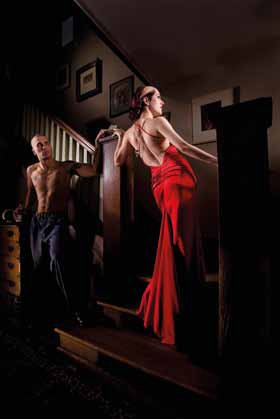articles/Lighting/holistic-page2
Go Holistic - part 2 of 1 2
by Dave Montizambert Published 01/10/2013

Dean's approach to lighting was holistic rather than specific to one situation. When I say holistic I mean he saw it as a whole - he carefully figured out all the interrelationships between lighting controls for creating light quality. For instance, when you move a light in closer to create softer edged shadows to de-emphasise facial blemishes, the specular highlights (glare or sheen) will increase in size as well as decrease in brightness, and if the shadows are lit or 'filled-in' with a reflector they will appear darker. So, even though all you wanted to do was de-emphasise facial blemishes, these other light qualities changed too. An understanding of these interrelationships allows you to select the best control for getting what you want and omitting what you do not want. In my articles, lectures, workshops and DVDs, I always include the underlying principles that make the lighting work on that shot, I believe that those principles are more important than how the shot was set up, but unfortunately it is the set-up of that shot that we value and not the underlying principles that allowed someone to arrive at that perfect set-up in the first place. Collin's 3 Dimensional Contrast has got me well paid to light and shoot everything from diamonds to aeroplanes, from automobiles to hamburgers, from people to electronics, often without prior knowledge of how to light such a thing.
When deciding on whom to learn from, I think we often miss out on great information because we choose by style and genre, dismissing those whose style we don't like - some of my best teachers created work I didn't like. If you break it down to its base level, style is the application of principles.
There is much knowledge to be had from non-photographic artists, I learned some cool things after a brief study of the Impressionist painters.
I believe it was Van Gogh who said something to the effect of, "Great art should not imprison the mind, it should set it free". What I believe he meant by this was, if he painted a photorealistic representation of a subject, object, or scene, the viewer's mind would be stuck on the canvas, 'imprisoned' as he said, because everything would have been laid out for you, your mind would be trapped. Whereas if he painted an impression of the above, that is broad strokes that suggest rather than depict, the painting would take place in the mind as much as it did on the canvas - the viewer's imagination would be fully engaged. It is much as our saying that the book is better than the movie. The book is better because it creates the story in your head, in your imagination, whereas the movie creates it outside of your head on a screen. One is like a cooked file like a JPEG or TIFF, the other a Raw file full of potential and interpretation. It is like great prose such as poetry which can say so much with so very little (something I obviously haven't grasped) because it creates in your imagination and does so in a nonlinear fashion.
My style of photography is dramatic and photographers have asked why I love dramatic lighting so much. My answer is twofold: first, I like working with darker shadows with very subtle detail because it creates a sense of mystery, it creates more of an impression rather than a depiction, it suggests rather than tells, and I think that is much more powerful and I think Van Gogh might approve. Second, photography is a two-dimensional medium; when we take a picture we flatten our three-dimensional world into a flat plane, all we have is height and width, depth is lost. To create an impression of reality we must create the illusion of depth. Your camera is helpful in this; a shallow DoF with the subject or part of the subject sharp and with the background and foreground going out of focus not only creates the way our eyes naturally see but also renders an illusion of depth. Also camera placement and framing can emphasise diverging and converging lines that lend a sense of depth. But the most powerful way to create depth on a flattened plane is with lighting - simply put, darkening tones makes them recede and lightening tones brings them forward.
In conclusion, I think that I am drawn to create lighting with big, fat, juicy, dark, dramatic shadows because as an artist I'm currently in my dark period, that period by the way, started 22 August 55 years ago! Be sure and come to my talks and workshops this coming January at the Societies' 2014 London Convention and learn to 'Go Holistic.'
Dave Montizambert lectures internationally on lighting, digital photography and Adobe Photoshop.
He is also a published author having written two books on lighting and digital photography (www.montizambert.com) plus numerous magazine articles on these topics in North America, Europe, Russia and Asia. Dave also creates Lighting and Photoshop tutorial DVDs for www.software-cinema.com and www.photoshopcafe.com. Dave is available for lectures and workshops in your area and can be reached through www.montizambert.com.
Please Note:
There is more than one page for this Article.
You are currently on page 2 Contact Dave Montizambert
1st Published 01/10/2013
last update 09/12/2022 14:54:59
More Lighting Articles
There are 5 days to get ready for The Society of Photographers Convention and Trade Show at The Novotel London West, Hammersmith ...
which starts on Wednesday 14th January 2026





